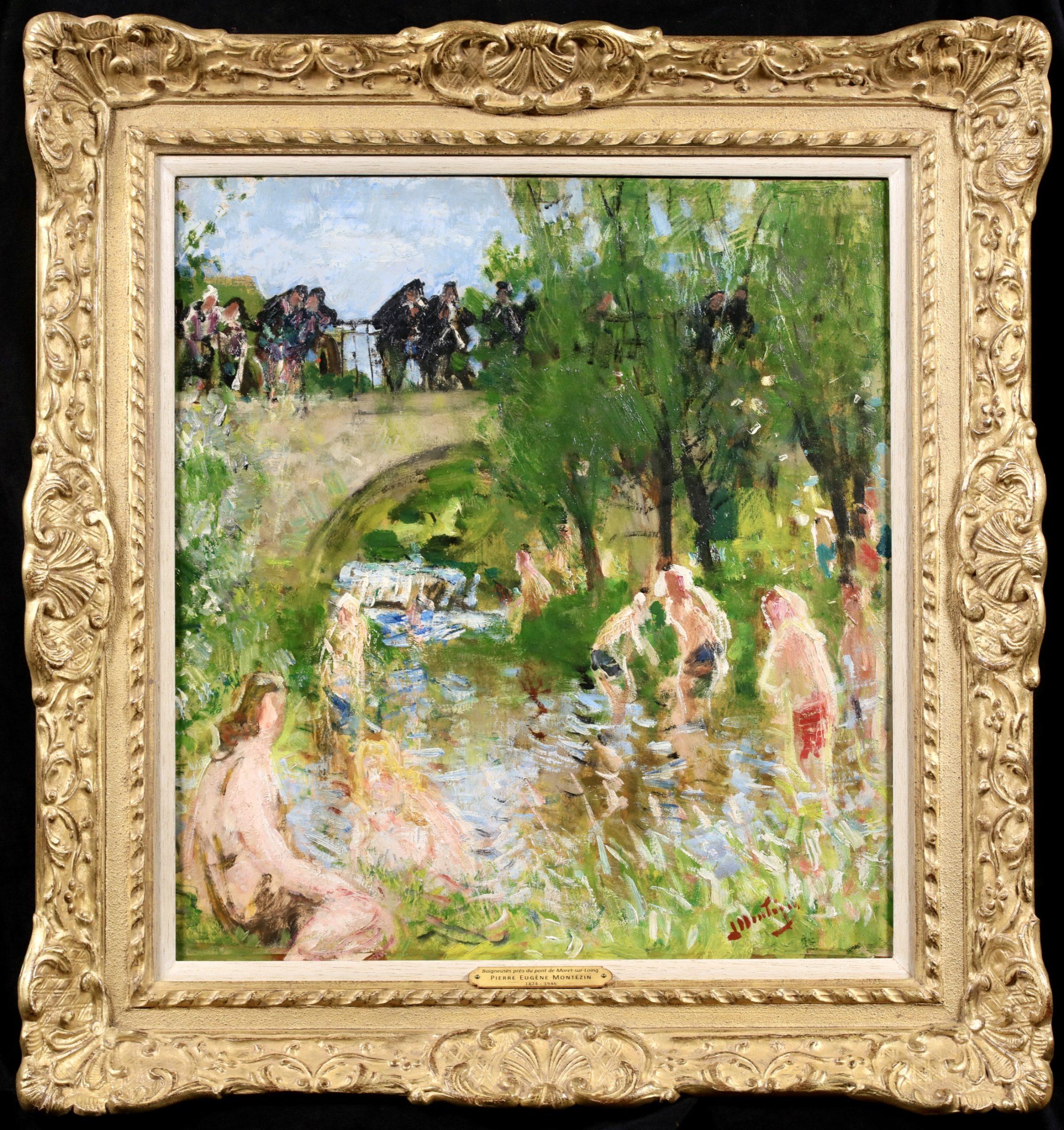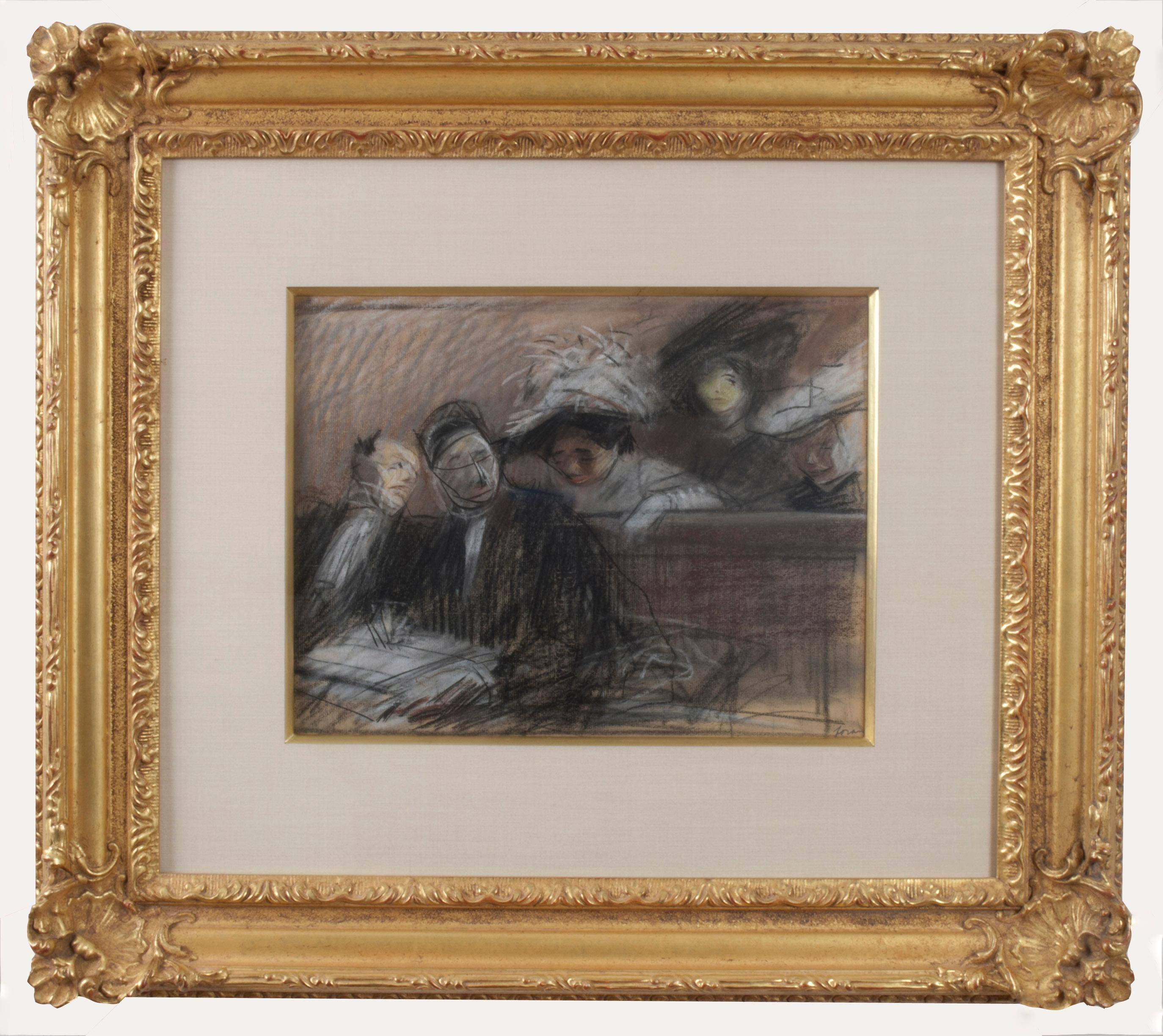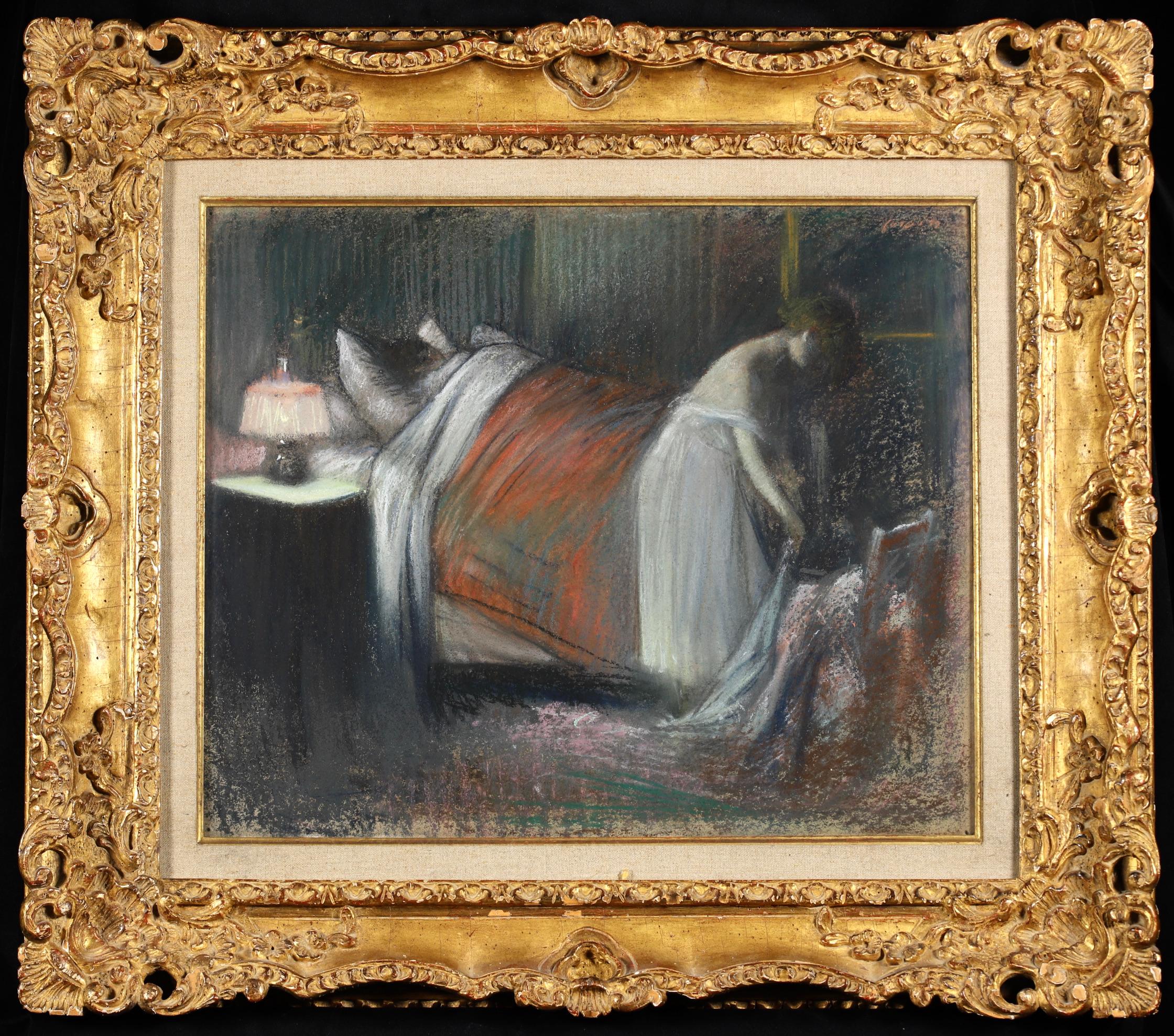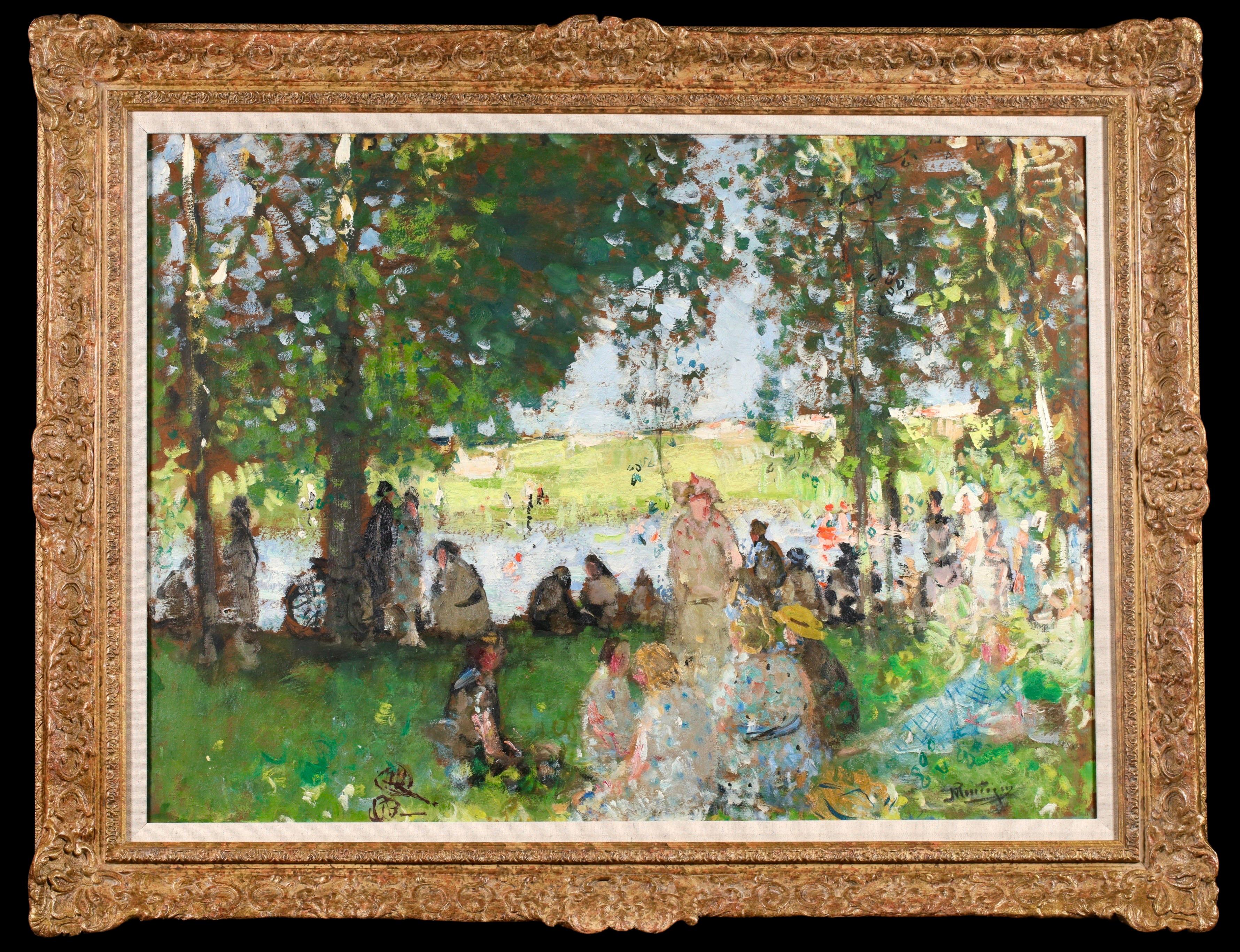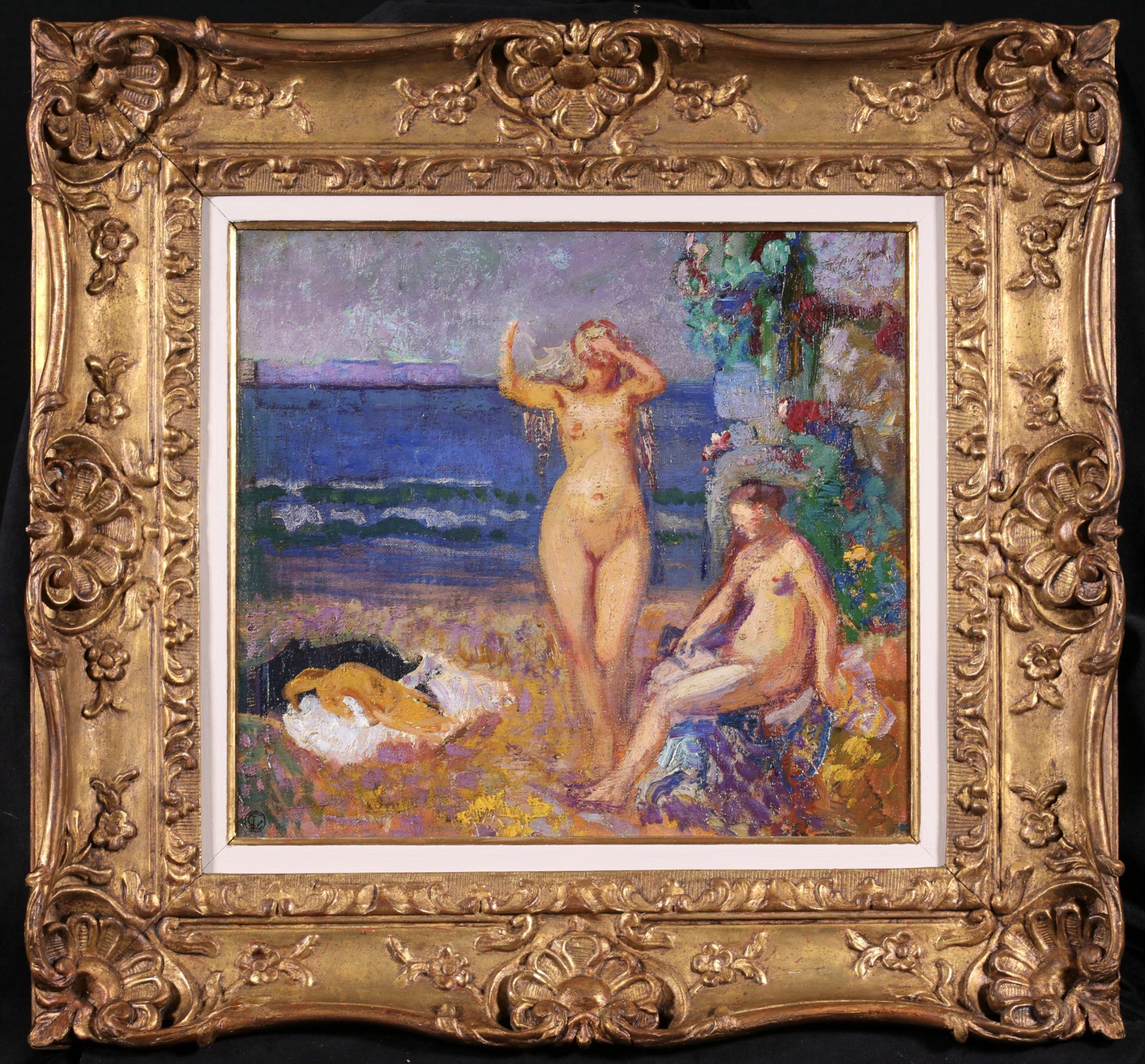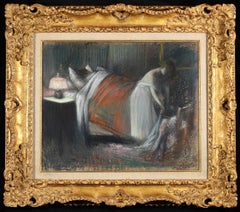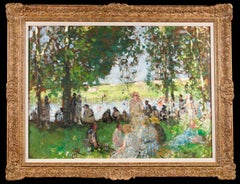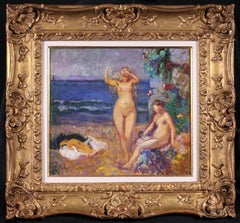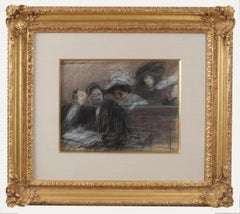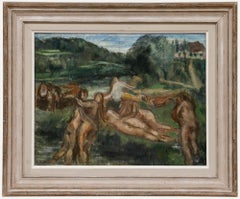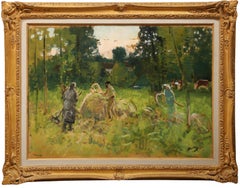Items Similar to Les Baigneuses - Impressionist Figurative Landscape Oil by Jean Louis Forain
Want more images or videos?
Request additional images or videos from the seller
1 of 14
Jean Louis ForainLes Baigneuses - Impressionist Figurative Landscape Oil by Jean Louis Forainc.1890
c.1890
$12,186.72
£8,835
€10,408.60
CA$16,739.64
A$18,613.52
CHF 9,744.51
MX$227,367.59
NOK 122,449.40
SEK 115,188.20
DKK 77,699.50
About the Item
Signed impressionist figurative oil on canvas circa 1890 by sought after French impressionist painter Jean Louis Forain. The piece depicts bathers in a dark landscape.
Signature:
Signed lower right
Dimensions:
Framed: 32"x37"
Unframed: 24"x29"
Provenance:
Private French collection
Jean Forain was the son of a painter and decorator and was apprenticed to a visiting card engraver. He studied briefly under Gérôme and Carpeaux at the École des Beaux-Arts in Paris and regularly visited the Louvre, where he copied works by the masters. It is said that for a time he made a precarious living by selling small drawings in the style of Grévin. He went on to collaborate on various publications as a draughtsman and columnist, starting in 1876 on La Cravache and then collaborating on the newspapers Le Journal Amusant, Le Figaro and L'Écho de Paris. This introduced him to the diverse worlds of Paris society - the world of the theatre, of shows, and of literature - where he wryly noted the habits and shortcomings particular to each. This led him to follow a route very characteristic of this period, already seen in the work of Steinlen, Caran d'Ache and Toulouse-Lautrec in the journals La Pléiade, La Vogue and La Revue Blanche.
His work draws a picture of the society of the period, not in a strictly imitative fashion but in the form of the 'dessin-charge' or mild caricature. In 1880 he illustrated Parisian Sketches (Croquis Parisiens) by J.-K. Huysmans. The newspapers on which he collaborated did not allow him sufficient freedom to express the causticity he felt, but the creation of the Courrier Français and later the Rire allowed him to give free rein to his particular eloquence. The political and financial scandal of the bankruptcy proceedings against the Compagnie Universelle du Canal Interocéanique in 1892 provided him with rich ground from which to observe wheeler-dealers and shady politicians swimming in the troubled waters of the legal world. He decided to assemble his drawings in thematic albums which together provide a tableau of the society of his time; these were, in 1892 L'Album Forain, La Comédie Parisienne, in 1893 Les Temps Difficiles, Nous, Vous, Eux and in 1897 Doux Pays. In the Dreyfus affair Forain was on the side of those opposed to a retrial, and in 1898-1899 he and Caran d'Ache founded Pss't ! which would become a vehicle of anti-Semitism - more ferocious than skilful - but one that would always find its market. Forain also founded the magazine Le Fifre and was one of the founder members of the Society of Humorists (Société des Humoristes). From 1914 to 1920 he produced a long series of illustrations on World War I for Le Figaro, in which he contrasted the heroism of the soldiers on the Front with the cowardice of those shirking in the background. He then underwent a religious conversion and devoted the final years of his life to pious subjects in which he was unable to employ the mainstay of his talent: his caustic wit and even a certain degree of spite. He was made a Chevalier of the Légion d'Honneur in 1893 and received numerous honours, including election to the Institut de France.
In addition to his many collaborations on magazines and journals of the period, Forain produced etchings and 99 lithographs, including some posters. Some of the albums of drawings he published contain series: La Comédie Parisienne, a series of 250 drawings, and Les Temps Difficiles, a series of 99 drawings. He also illustrated literary works, including: Les Pantins de Paris by Gustave Coquiot in 1920 and Les Tribunaux by Georges Courteline, 1931. He also collaborated on the illustration of La Vraie Tentation du Grand Saint Antoine, 1880, by Paul Arène, Chansons Fin de Siècle, 1891, by J. Oudot and Montmartre Immortel, 1922 by E. Bayard.
Early in his career Forain painted watercolours inspired by Japanese layouts. The somewhat neglected next stage of his career was as a painter and pastellist alongside his work as a caricaturist. It is thought that his admiration for Manet and the influence of Degas made their mark on his expansive technique, his incisive style and the choice of subjects in his pastel and gouache-heightened watercolours, his oil paintings and the clever, colourful studies that followed, such as those set in the wings of theatres, music cafés and bars.
He exhibited with his Impressionist friends Monet and Degas at the official Salon in 1884 and 1885 and, according to some sources, also in 1879, 1880 and 1881.
Solo Exhibitions:
1956, Museum of Springfield, Massachusetts
1978, Musée Marmottan, Paris
1995, Fondation de l'Hermitage, Lausanne
1996, Jean-Louis Forain: The Impressionist Years, Van Gogh Museum, Amsterdam
2003, Fondation Angladon-Dubrujeaud, Avignon
2003, Musée Yves Brayer, Les Baux-de-Provence
Museum and Gallery Holdings:
Aberdeen (AG and Mus.): La Salle d'Attente (oil on canvas)
Boston (MFA): Evidence in the Case (oil on canvas); Witness Confounded (1926, oil on canvas)
Bristol (City Mus. and AG): The Un-wed Mother (c. 1909)
Chicago (AI): Tight-Rope Walker (c. 1885, oil on canvas)
Ghent (Mus. voor Schone Kunsten): Dancers (oil on canvas)
London (Nat. Gal.): The Tub (c. 1886-1887, oil on canvas); Legal Assistance (c. 1900-1912, oil on canvas)
Los Angeles (County MA): The Picture Dealer (c. 1920, oil on canvas); Self-portrait (1922, oil on canvas)
Memphis (Dixon Gal.): collection of over 50 works
New York (Metropolitan Mus. of Art): Recess of the Court (oil on canvas)
Paris (Mus. d'Orsay): At the Nouvelle Athènes Café (watercolour); German Soldier in a Cemetery (oil on canvas); The Magistrates Court (oil on canvas); Portrait of the Artist (1906, oil on canvas); The Plea (1907, oil on canvas); The Studio (oil on canvas); The Widower (oil on canvas)
Philadelphia (MA): The Hearing (c. 1900, oil on canvas)
Southampton (City AG): The Fisherman (1884, oil on canvas)
St Petersburg (Hermitage): Music-Hall (1895-1896, oil on canvas)
Washington DC (Georgetown University): Backstage at the Opera Aida (c. 1898, pastel/paper)
Washington DC (NGA): Behind the Scenes (c. 1880, oil on canvas); Standing Woman with a Fan (c. 1880-1890); The Artist's Wife Fishing (1896, oil on canvas); The Petition (1906, oil on canvas); The Stockade (c. 1908, oil on canvas); The Requisition (c. 1919, oil on canvas); Artist and Model (1925, oil on canvas); The Charleston (1926, oil on canvas)
- Creator:Jean Louis Forain (1852-1931, French)
- Creation Year:c.1890
- Dimensions:Height: 32 in (81.28 cm)Width: 37 in (93.98 cm)
- Medium:
- Movement & Style:
- Period:
- Condition:Very good condition for age. two small repairs verso.
- Gallery Location:Marlow, GB
- Reference Number:Seller: LFA01181stDibs: LU415315145422
About the Seller
5.0
Gold Seller
Premium sellers maintaining a 4.3+ rating and 24-hour response times
Established in 2001
1stDibs seller since 2016
708 sales on 1stDibs
Typical response time: <1 hour
- ShippingRetrieving quote...Shipping from: Marlow, United Kingdom
- Return Policy
Authenticity Guarantee
In the unlikely event there’s an issue with an item’s authenticity, contact us within 1 year for a full refund. DetailsMoney-Back Guarantee
If your item is not as described, is damaged in transit, or does not arrive, contact us within 7 days for a full refund. Details24-Hour Cancellation
You have a 24-hour grace period in which to reconsider your purchase, with no questions asked.Vetted Professional Sellers
Our world-class sellers must adhere to strict standards for service and quality, maintaining the integrity of our listings.Price-Match Guarantee
If you find that a seller listed the same item for a lower price elsewhere, we’ll match it.Trusted Global Delivery
Our best-in-class carrier network provides specialized shipping options worldwide, including custom delivery.More From This Seller
View AllLes Baigneuses - Post Impressionist Figures in Landscape Oil by Pierre Montezin
By Pierre Eugène Montezin
Located in Marlow, Buckinghamshire
Signed oil on canvas figures in riverscape circa 1910 by sought after French impressionist painter Pierre Eugene Montezin. The work depicts bathers in a river on a sunny summer's day...
Category
1910s Impressionist Figurative Paintings
Materials
Canvas, Oil
Le Lever - Impressionist Figures in Interior Pastel by Jean Louis Forain
By Jean Louis Forain
Located in Marlow, Buckinghamshire
Signed impressionist figurative pastel on board circa 1895 by sought after French impressionist painter Jean Louis Forain. The piece depicts a man asleep in a bed while a woman stands at the foot of the bed getting dressed. The room is dimly lit by the bedside lamp.
Signature:
Signed upper right
Dimensions:
Framed: 22"x26"
Unframed: 15"x19"
Provenance:
Galerie Jean-Claude Bellier
Jean Forain was the son of a painter and decorator and was apprenticed to a visiting card engraver. He studied briefly under Gérôme and Carpeaux at the École des Beaux-Arts in Paris and regularly visited the Louvre, where he copied works by the masters. It is said that for a time he made a precarious living by selling small drawings in the style of Grévin. He went on to collaborate on various publications as a draughtsman and columnist, starting in 1876 on La Cravache and then collaborating on the newspapers Le Journal Amusant, Le Figaro and L'Écho de Paris. This introduced him to the diverse worlds of Paris society - the world of the theatre, of shows, and of literature - where he wryly noted the habits and shortcomings particular to each. This led him to follow a route very characteristic of this period, already seen in the work of Steinlen, Caran d'Ache and Toulouse-Lautrec in the journals La Pléiade, La Vogue and La Revue Blanche.
His work draws a picture of the society of the period, not in a strictly imitative fashion but in the form of the 'dessin-charge' or mild caricature. In 1880 he illustrated Parisian Sketches...
Category
Late 19th Century Impressionist Figurative Paintings
Materials
Board, Pastel
Les Vacances - Post Impressionist Figures in Landscape Oil by Pierre Montezin
By Pierre Eugène Montezin
Located in Marlow, Buckinghamshire
Signed oil on canvas figures in riverscape circa 1910 by sought after French impressionist painter Pierre Eugene Montezin. The work depicts women dressed in summer dresses and sunhat...
Category
1910s Impressionist Figurative Paintings
Materials
Canvas, Oil
Les Baigneuses - Neo-Impressionist Nudes in Landscape Oil by Georges Lemmen
By Georges Lemmen
Located in Marlow, Buckinghamshire
Signed oil on canvas nudes in landscape circa 1910 by Belgian neo-impressionist painter Georges Lemmen. The work depicts nude bathers on a sunny beach beside the sea.
Signature:
Signed lower left with the cachet of painter
Dimensions:
Framed: 23.5"x24.5"
Unframed: 14.5"x15.5"
Provenance:
Olivier Bertrand (expert on the painter) has confirmed the authenticity of this work
Georges Lemmen was the son of an architect and studied under Amédée Bourson at the academy in St Joost-ten-Node. He was invited in 1889 to join the Group of Twenty ( Cercle des XX) which had been launched in 1884 by Oscar Maus and had in the interim emerged as an influential force in Belgian artistic circles, not least by bringing to public and critical attention the work of such artists as Georges Seurat and Paul Signac. The Cercle des XX would be reborn in 1894 as La Libre Esthétique.
In the early days of the Cercle des XX, Lemmen espoused a pointilliste technique. His earlier painting was clearly influenced by the Neo-Impressionists; over time, however, his style became more subtle and nuanced - recalling, perhaps, that of his compatriot Van Rysselberghe, another Cercle des XX member. With the group's rebirth as the Libre Esthétique, Lemmen's work became more intimiste in character, most notably in his portraits, nudes and still-lifes, where the influence of Bonnard and Vuillard is unmistakable, as is that of Renoir, particularly after Lemmen's travels in the Midi in 1911. From this point onwards, he would go on to make a major contribution to the renewal of the graphic and decorative arts in terms of his input to the new 'free' aesthetic and to Art Nouveau. Although his draughtsmanship retained its essential purity and elegance of line, his painting became more fleshy, imprecise and sensual, his compositions governed less by technical considerations than by the urgent need to express his emotions.
Between 1889 and 1893, Lemmen exhibited at the Salon des Indépendants in Paris, aligning himself with the Neo-Impressionists. In 1893, Henry van de Velde invited him to participate in the Pour l'Art association that had been created in Antwerp. He travelled to the south of France in 1911. By this juncture, he had already exhibited solo on two occasions (in 1906 and 1908) at the Galerie Druet in Paris. A further solo exhibition in 1913, his first in Brussels, cemented Lemmen's reputation.
Museum and Gallery Holdings:
Bremen (Kunsthalle): Standing Nude Combing her Hair
Brussels (Mus. royaux des Beaux-Arts de Belgique): Children's Room (watercolour); Reading; Couture; Young Girl by the Sea...
Category
1910s Impressionist Nude Paintings
Materials
Oil, Canvas
L'Etang - Post Impressionist Figures in Landscape Oil by Max Agostini
By Max Michel Agostini
Located in Marlow, Buckinghamshire
Signed post impressionist figures in landscape oil circa 1980 by French painter Max Michel Agostini. The work depicts park-goers on a path beside a lake on a sunny spring day. There ...
Category
1980s Post-Impressionist Landscape Paintings
Materials
Canvas, Oil
Nu allonge - Post Impressionist Nude Figurative Oil - Georges D'Espagnat
By Georges d'Espagnat
Located in Marlow, Buckinghamshire
Signed oil on panel nude circa 1920 by French post impressionist painter Georges D'Espagnat. The work depicts a nude woman laying a patch of green grass on top of a hill with a view of the valley in the distance.
Signature:
Signed lower right
Dimensions:
Framed: 16"x20"
Unframed: 9"x13"
Provenance:
A certificate of authenticity for this work is available from Mr. Jean Dominique Jacquemond upon request
Private French collection
From the beginning of his career, it was a constant concern of Georges d'Espagnet to assert his originality. His studies at the École des Arts Décoratifs, Paris, did not last very long, for he wanted immediate independence and decided to follow courses in the private academies of Montparnasse. In about 1900, he became acquainted with Maurice Denis, Bonnard and Vuillard, and his collaboration with Denis led to a renewal of religious art in France.
In 1903, d'Espagnet was one of the founders of the Salon d'Automne, and was appointed professor in charge of studios at the École des Beaux-Arts, Paris, in 1934. He illustrated a number of books: Rémy de Gourmont's Evil Prayers ( Oraisons mauvaises) (1896), The Saints of Paradise ( Les Saintes du paradis) (1898), Simone (1907), Sistine ( Sixtine) (1922); Alphonse Daudet's The Immortal ( L'Immortel) (1930); André Gide's The Pastoral Symphony ( La Symphonie pastorale); Francis Jammes' Clearings in the Sky ( Chairières dans le ciel) (1948).
D'Espagnet belongs to the group of artists who made the Courrier Français so successful. The drawings of his which are published in it are strongly expressive and some bear comparison with the designs of the great Renaissance masters. He also contributed to L'Image. He often placed cheerful nudes in a landscape, reminding us that, though he moved away from the Fauves, he retained their freedom of colour and arabesque. He painted many portraits, including those of Albert André, André Barbier, Victor Boucher, Déodat de Séverac, Albert Marque, André Marty and Albert Roussel. He also painted mural decorations, including a wall for the Palais de la Découverte (1937), the ceiling of the Victor Hugo Room in the Palais du Luxembourg (1939), a decorative panel for the Palais de Justice, Toulouse (1941) and interior decorations for private houses. His landscapes are Impressionist in inspiration, and work for a certain sobriety, an intimacy, both in their composition - one, two or three sketched figures and large open spaces - and in the choice of colours and treatment with the special hazy brushstroke that marks his style.
D'Espagnet took part in a number of annual Parisian exhibitions, including the Salon des Indépendants, the Salon de la Société Nationale des Beaux-Arts, the Salon d'Automne (from 1903 to 1949, except in special circumstances), the Salon de la Libre Ésthétique, Brussels (1899, 1901), the Berlin Secessionists (1940). He also exhibited at the first Salon de la Société de la Gravure sur Bois. Among other exhibitions were 1912, A Century of French Art ( Centenaire de l'art français), St Petersburg; 1916, Kunstverein, Winterthur; 1918, 1926, Galerie M. Bertheim, Paris; 1930, Contemporary French Art...
Category
1920s Post-Impressionist Nude Paintings
Materials
Oil, Panel
You May Also Like
Le Resesquement a l'Advocats (The Legal Reservation)
By Jean Louis Forain
Located in Fairlawn, OH
Le Resesquement a l'Advocats
(The Legal Reservation)
Pastel on paper, c. 1910
signed lower right
Image size: 10 3/4 x 14 inches
Frame size: 23-1/2 x 26-1/2 x 2-3/8 inches
Condition: ...
Category
Early 1900s Impressionist Figurative Paintings
Materials
Pastel
Le Pays Reconquis
By Jean Louis Forain
Located in San Francisco, CA
Artist: Jean-Louis Forain (French, 1852-1931)
Title: Le Pays Reconquis
Year: 1918
Medium: Lithograph
Edition: Numbered 266/300 in pencil
Paper: Wove
Size p...
Category
Early 20th Century Impressionist Figurative Prints
Materials
Lithograph
Georges Eugene Delhomme (1904-1989) - 1928 Oil, Figures in a Landscape
Located in Corsham, GB
This impressionistic painting portrays a serene pastoral scene, where nude figures are gracefully integrated into a lush, verdant landscape. The composition skilfully balances the or...
Category
Early 20th Century Figurative Paintings
Materials
Oil
Les Foins, Impressionist Oil on Canvas Painting by Pierre Eugène Montézin
By Pierre Eugène Montezin
Located in Long Island City, NY
Pierre Montezin, French (1874 - 1946) - Les Foins, Year: 1938, Medium: Oil on Canvas, signed lower right, Size: 23.75 x 31.75 in. (60.33 x 80.65 cm), Frame Size: 31.25 x 39.5 inc...
Category
1930s Impressionist Nude Paintings
Materials
Oil
Elegant Ladies Walking French River Landscape Signed Antique Oil Painting
Located in Cirencester, Gloucestershire
Afternoon Stroll
Louis Faille (French 1878-1964)
signed oil on board, unframed
board : 27.5 x 20.5 inches
Provenance: private collection, Paris
Condition: very good condition
Descri...
Category
Early 20th Century Post-Impressionist Figurative Paintings
Materials
Oil
$955 Sale Price
30% Off
Loin du Front
By Jean Louis Forain
Located in San Francisco, CA
Artist: Jean-Louis Forain (French, 1852-1931)
Title: Loin du Front
Year: 1918
Medium: Lithograph
Edition: Numbered 85/300 in pencil
Paper: Wove
Sheet size: 15 x 22.25 inche...
Category
Early 20th Century Impressionist Figurative Prints
Materials
Lithograph
More Ways To Browse
Le Cafe
St Louis Impressionist Paintings St Louis
French Court Scene Paintings
Framed French Fans
German Portrait Painting 1920
C Milder
Woman Swimming
Soldier Etching
E Walker
Le Fanion
Monet Etching
Impressionist Paintings Of Swimming
Antique George Washington Painting
Charleston Oil Painting
Charleston Landscape Art
La Parisienne
Parisian Cafe Oil Painting
1900 Portrait Of A Woman Oil
